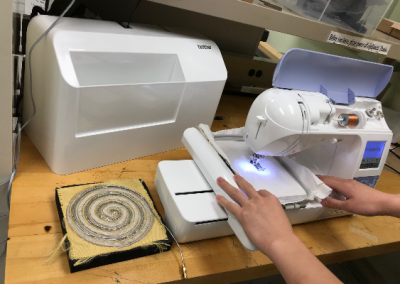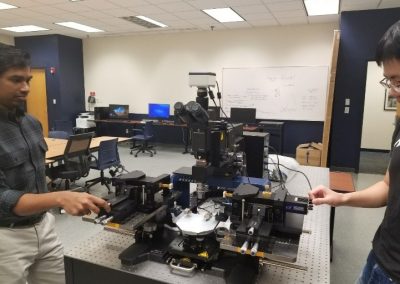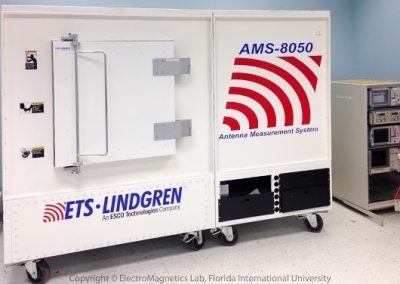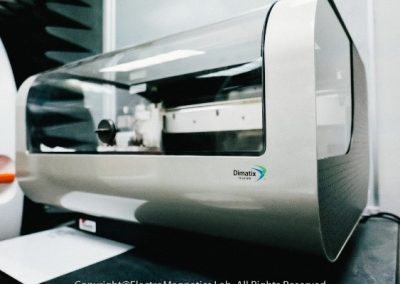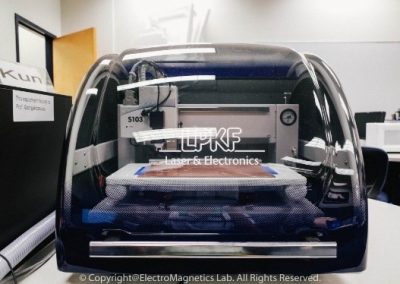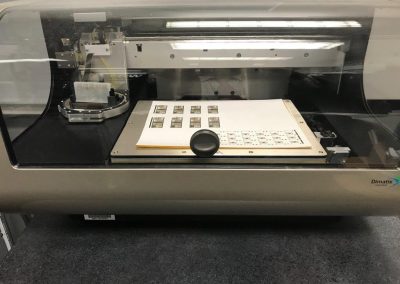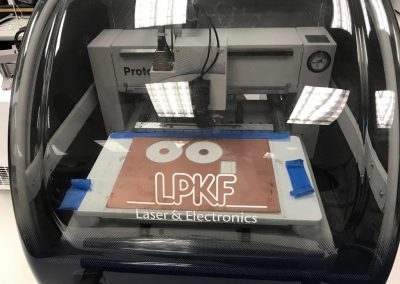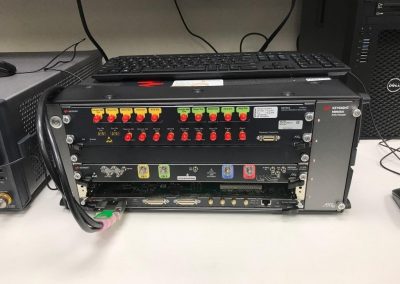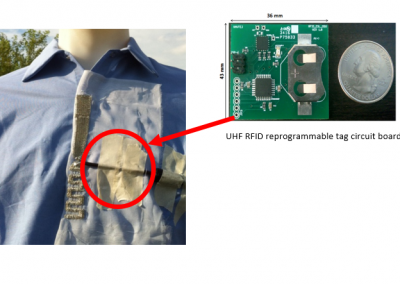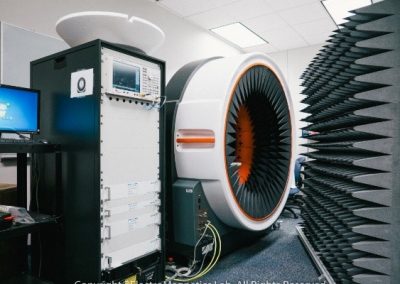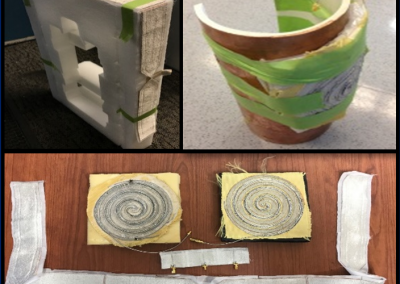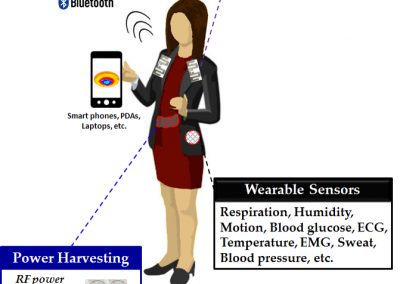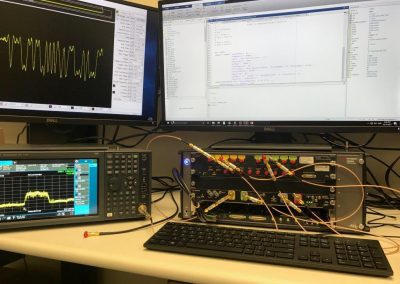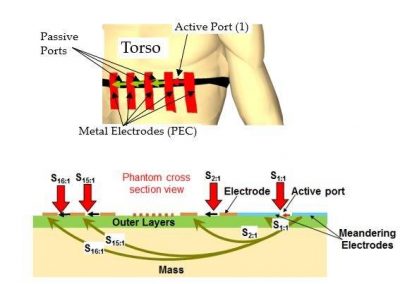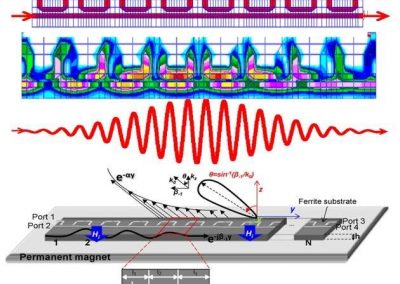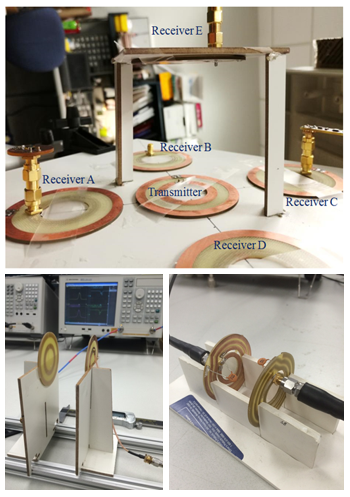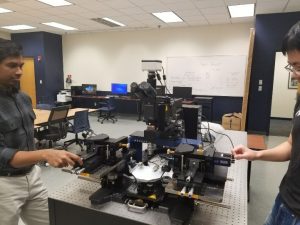
Medical Sensing
Our group is developing inconspicuous, game-changing sensors for a very wide range of medical applications. Among others, we aim to establish novel technologies for:
Safe and reliable brain implants: Brain implant technology has a strong potential to improve the individual’s well-being. However, current/in-research brain implants lack the safety and reliability required for unobtrusive, long-term monitoring of neuropotentials. Our approach is unique as it is fully-passive and wireless, a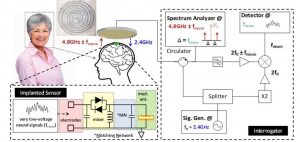 nd overcomes previous challenges. Specifically, we are introducing 1) fully-passive implants, implying that no active devices/components exist within the implants (no battery, energy harvesting unit, or rectifier/regulator), 2) wireless operation for unobtrusive monitoring with minimum impact to the individual’s activity, 3) extremely simple on-board electronics that generate minimal heat to ensure patient safety, and 4) integration of all required electronics in a tiny footprint to minimize trauma.
nd overcomes previous challenges. Specifically, we are introducing 1) fully-passive implants, implying that no active devices/components exist within the implants (no battery, energy harvesting unit, or rectifier/regulator), 2) wireless operation for unobtrusive monitoring with minimum impact to the individual’s activity, 3) extremely simple on-board electronics that generate minimal heat to ensure patient safety, and 4) integration of all required electronics in a tiny footprint to minimize trauma.
Wearable imaging sensors: Imaging plays a central role in several clinical and often life-saving decisions. Our aim is to provide continuous real-time tissue characterization using wearable sensors. With this in mind, we are developing a portable imager as a low-cost alternative to MRI/CT devices. Other features of are: 1) large penetration depth, 2) detection of small tissue changes, and 3) suppression of outer tissue layers (skin, fat, muscle) that vary among individuals.
Flexible Wearable Electronic Antennas:
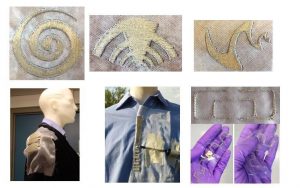 Our group has developed a new class of electromagnetically functionalized garments that have excellent electrical and mechanical properties. These electronic textiles aim to provide a new paradigm in addressing a multitude of wireless connectivity for healthcare applications. Our fabrication process is based on automated embroidery of metal-coated polymer E-fibers, down to 0.12mm in diameter. The employed E-fibers are silver-coated p-phenylene-2,6-benzobisoxazole (PBO) or liquid crystal polymer (LCP) filaments bundled into groups of 7s to 600s to form threads for use in programmable sewing machines. These textile surfaces feel and behave like any other clothing. At the same time, their RF performance is as good as that of copper, even after 10s of washings. Our automated embroidery process is not limited by thickness or material types.
Our group has developed a new class of electromagnetically functionalized garments that have excellent electrical and mechanical properties. These electronic textiles aim to provide a new paradigm in addressing a multitude of wireless connectivity for healthcare applications. Our fabrication process is based on automated embroidery of metal-coated polymer E-fibers, down to 0.12mm in diameter. The employed E-fibers are silver-coated p-phenylene-2,6-benzobisoxazole (PBO) or liquid crystal polymer (LCP) filaments bundled into groups of 7s to 600s to form threads for use in programmable sewing machines. These textile surfaces feel and behave like any other clothing. At the same time, their RF performance is as good as that of copper, even after 10s of washings. Our automated embroidery process is not limited by thickness or material types.
Our group introduced a new class of textile antennas on polymer substrates. Such a unique combination offers excellent RF 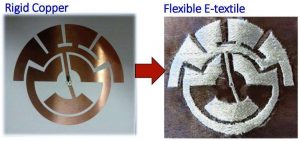 performance, mechanical strength and flexibility for emerging structural conformal and multi-functional RF designs. Example applications include but are not limited to: a) textile antennas integrated upon several everyday garments; including suits, shirts, and scarfs, b) textile-based RFIDs, c) stretchable and flexible textile antennas embedded in polymer for operation in harsh environments (e.g., automotive, implantable, wearable, etc., d) body-worn medical sensors (e.g., deep-tissue imaging sensors), and e) textile antennas for integration into vehicles, particularly small air and ground vehicles.
performance, mechanical strength and flexibility for emerging structural conformal and multi-functional RF designs. Example applications include but are not limited to: a) textile antennas integrated upon several everyday garments; including suits, shirts, and scarfs, b) textile-based RFIDs, c) stretchable and flexible textile antennas embedded in polymer for operation in harsh environments (e.g., automotive, implantable, wearable, etc., d) body-worn medical sensors (e.g., deep-tissue imaging sensors), and e) textile antennas for integration into vehicles, particularly small air and ground vehicles.
RESEARCH GALLERY
Wideband Transceivers:
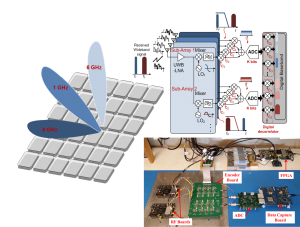 Ultra-wideband systems with beamforming capabilities are essential to realizing future 5G communications. Due to their large bandwidth operation, beamforming must be carried out in the digital domain. The latter implies a new class of back-end RF circuitry and post-processing techniques.
Ultra-wideband systems with beamforming capabilities are essential to realizing future 5G communications. Due to their large bandwidth operation, beamforming must be carried out in the digital domain. The latter implies a new class of back-end RF circuitry and post-processing techniques.
Our group has introduced and demonstrated a novel digital beamforming architecture. The proposed system eschews traditional phase-shifter-based approaches. Instead, at the receiver side, the antenna outputs are multiplexed into the analog domain and digitized using a single ADC. Subsequently, de-multiplexing and beamforming are performed in the digital domain. This approach reduces analog hardware and ADC power by a factor of 10 to 32. Application of such systems to RF and up to millimeter-waves are being pursued for secure high data rates communications.
Small and Wideband Antennas:
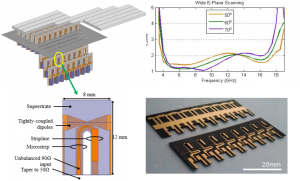 Over the years, our group has brought forward many innovations in small, thin and ultra-wideband (UWB) antennas. Current work in the area ranges from RF and up
Over the years, our group has brought forward many innovations in small, thin and ultra-wideband (UWB) antennas. Current work in the area ranges from RF and up 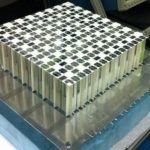 to millimeter wave frequencies beyond 100GHz. Some of the proposed apertures/arrays have allowed for up to 10 times smaller elements, and 4-5 times thinner apertures, and over 13:1 continuous bandwidth has been demonstrated experimentally. The ensuing concept is based on tightly coupled dipole arrays, often referred to as connected arrays, a concept originally proposed by the late Ben Munk at Ohio State in 2002.
to millimeter wave frequencies beyond 100GHz. Some of the proposed apertures/arrays have allowed for up to 10 times smaller elements, and 4-5 times thinner apertures, and over 13:1 continuous bandwidth has been demonstrated experimentally. The ensuing concept is based on tightly coupled dipole arrays, often referred to as connected arrays, a concept originally proposed by the late Ben Munk at Ohio State in 2002.
Antenna and array miniaturization has been achieved via emulated in-plane 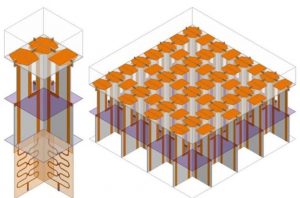 anisotropy, leading to continuous theoretical bandwidth of as much as 36:1 bandwidths on a very thin (0.06l thick at the lowest frequency) substrate. These design have been supplemented with wideband feed networks and with reconfiguration circuits to control the bandwidth and band rejection regions. In addition, parasitic metallic frequency selective surfaces (FSSs) have been introduced to achieve low scanning angle down to 75o.
anisotropy, leading to continuous theoretical bandwidth of as much as 36:1 bandwidths on a very thin (0.06l thick at the lowest frequency) substrate. These design have been supplemented with wideband feed networks and with reconfiguration circuits to control the bandwidth and band rejection regions. In addition, parasitic metallic frequency selective surfaces (FSSs) have been introduced to achieve low scanning angle down to 75o.
Computational Electromagnetics:
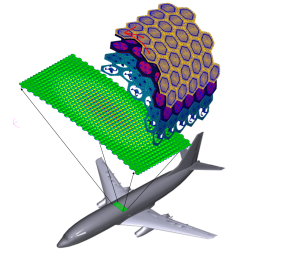 Our group has provided innovations in many aspects of the currently established electromagnetic computational methods including Finite Element, Integral Equations, Fast Multipole Methods, and High Frequency Methods, as well as their hybrid versions. Several of the initial successes in the finite element-boundary integral methods were introduced in the late 1980s and early 1990s, and applications to large scale computational problems in antennas and scattering were pursued in the late 90s and early 2000s (1), (2). Current research relates to multi-physics computational tools, hybridizations with lumped circuits and integrated RFICs, design optimization, reconfigurable arrays and RF systems, conformal array structures on complex platforms, and frequency selective surfaces among others.
Our group has provided innovations in many aspects of the currently established electromagnetic computational methods including Finite Element, Integral Equations, Fast Multipole Methods, and High Frequency Methods, as well as their hybrid versions. Several of the initial successes in the finite element-boundary integral methods were introduced in the late 1980s and early 1990s, and applications to large scale computational problems in antennas and scattering were pursued in the late 90s and early 2000s (1), (2). Current research relates to multi-physics computational tools, hybridizations with lumped circuits and integrated RFICs, design optimization, reconfigurable arrays and RF systems, conformal array structures on complex platforms, and frequency selective surfaces among others.
Millimeter Waves and TeraHertz:
Current research includes design and development of the THz devices, including HEMTs, millimeter transceivers, millimeter antennas, millimeter wave satellite links, energy harvesting and circuits, and associated measurements and characterization. There is strong and continuing interest for high data rate millimeter wave transceivers with wideband beamformers.
Slow Wave and Metamaterial Structures:
Research on slow wave structures, bandgap materials and related configurations have been carried out by our group since late 90s 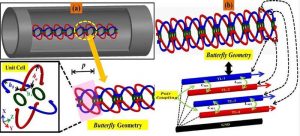 as part of the DARPA Metamaterials program. Applications to antennas was continued through the AFOSR MURI on Novel Materials for Antennas and RF Devices, and under ONR and ARL funding for miniature antennas using ceramic composites, synthetic polymers and magnetic materials. Applications to traveling wave tubes and backward wave oscillators based on slow-wave phenomena are also being carried out under the AFOSR MURI program entitled “Innovative Use of Metamaterials in Confining, Controlling, and Radiating Intense Microwave Pulses”.
as part of the DARPA Metamaterials program. Applications to antennas was continued through the AFOSR MURI on Novel Materials for Antennas and RF Devices, and under ONR and ARL funding for miniature antennas using ceramic composites, synthetic polymers and magnetic materials. Applications to traveling wave tubes and backward wave oscillators based on slow-wave phenomena are also being carried out under the AFOSR MURI program entitled “Innovative Use of Metamaterials in Confining, Controlling, and Radiating Intense Microwave Pulses”.

